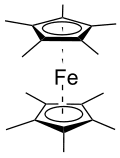Appearance Yellow crystalline solid | ||
 | ||
Decamethylferrocene is a sandwich compound. In terms of structure and bonding it resembles ferrocene, but with a methyl group on each of the carbons of the Cp rings. It is a yellow crystalline solid that is a weak reductant.
Contents
Preparation
Decamethylferrocene is prepared in the same manner as ferrocene from pentamethylcyclopentadiene. This method can be used to produce other decamethylcyclopentadienyl sandwich compounds.
2 Li(C5Me5) + FeCl2 → Fe(C5Me5)2 + 2 LiClThe product can be purified by sublimation. FeCp2* has staggered Cp* rings. The average distance between iron and each carbon is approximately 2.050 Å. This structure has been confirmed by X-ray crystallography.
Redox reactions
Like ferrocene, decamethylferrocene forms a stable cation because Fe(II) is easily oxidized to Fe(III). Because of the electron donating methyl groups on the Cp* groups, decamethylferrocene is more reducing than is ferrocene. In a solution of MeCN the reduction potential for the [FeCp2*]+/0 couple is -0.48 V compared to a [FeCp2]0/+ reference (-0.59 V V vs Fc/Fc+ in CH2Cl2). Oxygen is reduced to hydrogen peroxide by decamethylferrocene in acidic solution.
Using powerful oxidants (e.g. SbF5 or AsF5 in SO2, or XeF+ Sb2F11− in HF/SbF5) decamethylferrocene is oxidized to a stable dication. In the Sb2F11− salt, the Cp* rings are parallel. In contrast, a tilt angle of 17° between the Cp* rings is observed in the crystal structure of the SbF6− salt.
